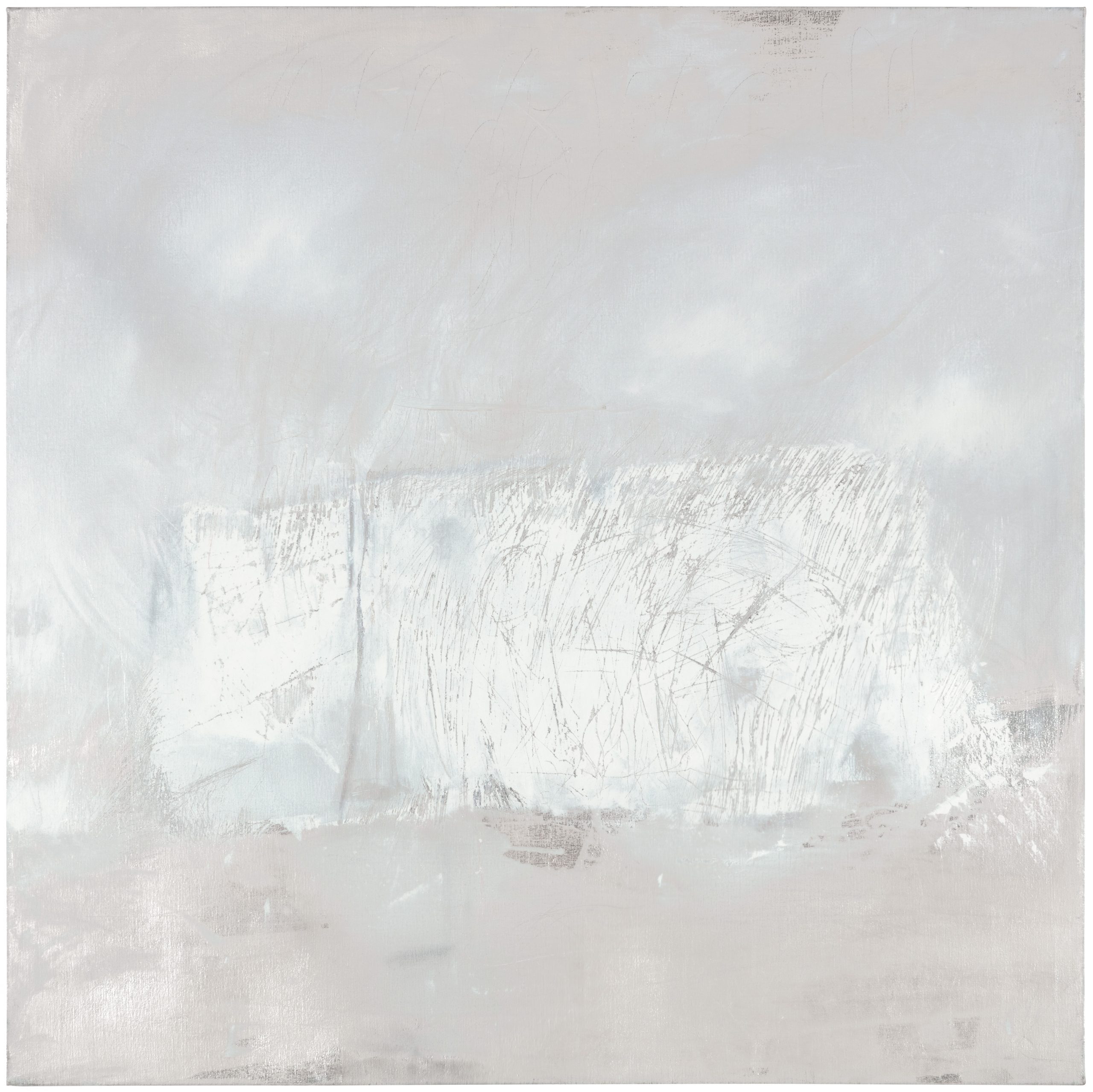
Zero degree, 2019
Silver sheets and oil on canvas – 100x100cm
the DEGREE ZERO of all things
“…a way of certain silence has of existing;
it deliberately foregoes any elegance or ornament”[1]
On a rainy afternoon in Lisbon, we climb a narrow wooden staircase with difficulty in order to plunge into a certain space. Jagged, sinuous, labyrinthine, warm, formally similar to a house. However in its various rooms we perceive a set of actions that move away from domestic functionality to quickly approach a rigorous discipline with its own procedures and regulations. We are in a work space – a studio – and the measure of its physical characteristics derives absolutely from the needs inherent to the practice developed there: Painting (and its various unfoldings).
Since the mid-1990s, Catarina Pinto Leite has been developing a pictorial practice that results from a clear interest in ‘landscape’ understood as a model of representation. Through a careful and synthetic technical mastery – based on her training in the restoration of ancient painting – she has developed a plastic research around the temporal and spatial dimensions of the landscape, its exteriority and interiority, its limits and borders and how its presence can be agglutinating for the physical presence of the spectator and, more particularly, for the constitution of a certain look.
Pinto Leite takes an approach that establishes a dialogue between its various processes of relationship – rational, emotional, oneiric, projective. These are always based on the processes of memory (sometimes resorting to its archive of personal memories, sometimes making use of aspects or episodes arising from a collective, shared memory). By doing so it proposes sets of artworks that result from explorations around an atmospheric language, tending towards abstraction, which seems to want to conjure a certain sense of transcendence.
When the word ‘landscape’ is commonly used, we tend to refer to a certain part of the real world (which is exterior to us), that is, we speak of a certain plane of vision that is directed to the field of the visible (to what is outside us available to be seen). Now, this vulgarisation tends to forget that the term ‘landscape’ results from a mental conception, from a systematised way of ordering the visible based on defining and structuring principles that allow us to establish a certain relation with the visible field through its transformation into image. A ‘landscape’ is, therefore, always an image. A ‘landscape’ is, therefore, always a construction. And as such, it results from a hierarchy based on a compositional equilibrium that is inferred from an idea of world order (a pre-order, anterior to the human, supra-human, … ultimately divine).
The set of paintings presented in the exhibition GRAU ZERO is the result of several attempts to approach this dimension, and, in particular, to an idea of the rarefaction of the landscape established from its near invisibility. A kind of search for the limits of representation through a model of representation that projects itself into its erasure (sometimes through the accumulation of the pictorial matter, sometimes through its rare, or almost non-existent, presence).
Let us take as an example the two larger paintings (with the titles “Dive Into” and “Grau Zero”, dated respectively 2020 and 2019) to approach another dimension that seems to be summoned by Catarina Pinto Leite’s work: the extent to which her landscapes seem to be able to constitute themselves, for the viewer, as territories for the construction of a physical relationship and, consequently, generative of a certain idea of space.
We are faced with rarefied, evasive, undressed images, scarcely described, constructed from the combination of pictorial matter (oil) – vastly reduced in its chromatic palette – and the application of which was subject to successive advances and retreats, a series of layers that, in turn, cover or unblock, hide or reveal, announce or denounce, invoke or affirm. It is precisely this chromatic palette, reduced to a minimum, its ample distribution, the scale and the lack of objective limits for its reading that seem to be able to summon the spectator’s memory and, very specifically, the memory of a certain physical experience.
The time-consuming process of visual recognition invokes a physical memory which, in turn, feeds the process of visual recognition. Everything happens cyclically. We are faced with visual elements that invoke a specific physical memory: the touch of the snow, the sensation of cold, the difficulty of observation in an icy spatial context. And, although we find ourselves in a place that is proposed to us as a sort of zero degree of all things (that “way of existing of a silence”, as Barthes states), it is precisely through this evocation of a physical memory that we solidly construct the belief that we are facing a ‘landscape’.
Ana Anacleto
December 2022
Translation: Teresa Bernauer
[1] Barthes, Roland